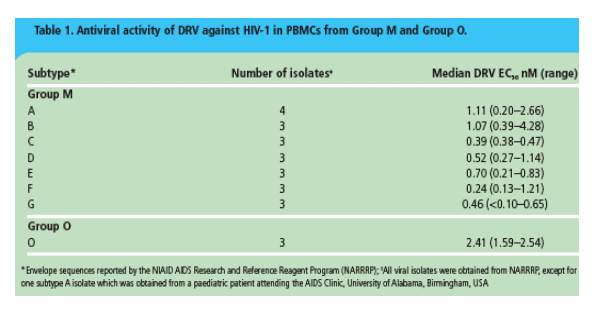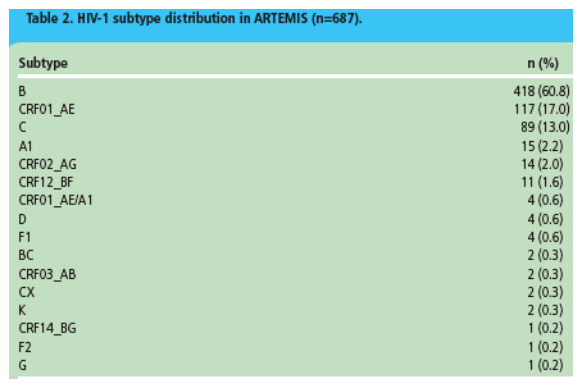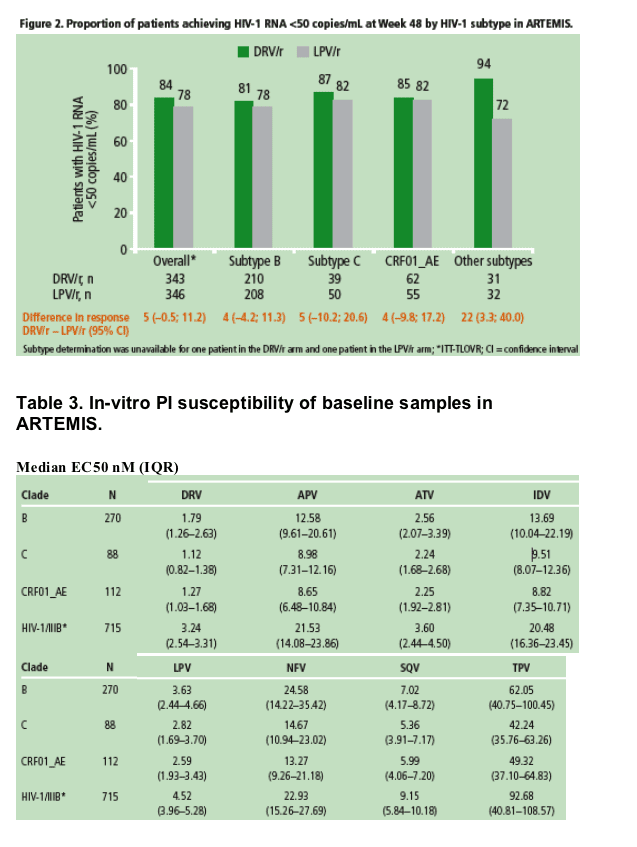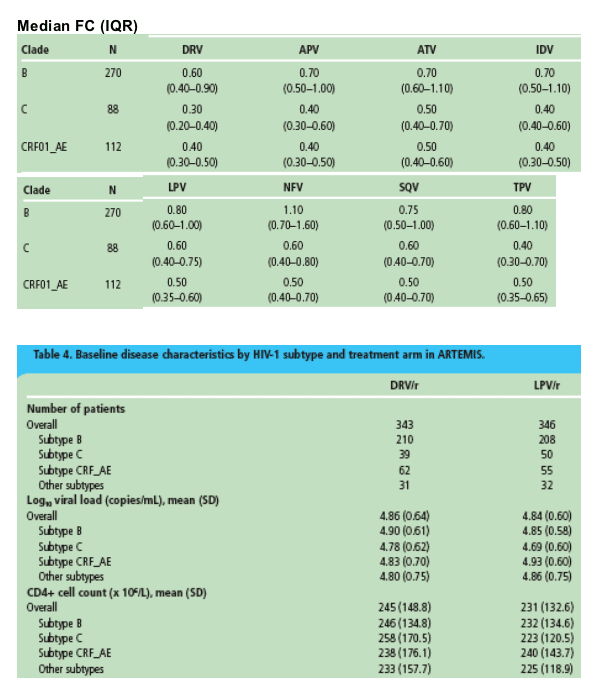 |
 |
 |
| |
Comparable in-vitro susceptibility and virological outcome to darunavir in patients infected with subtype B and non-subtype B HIV isolates participating in the ARTEMIS Phase III trial
|
| |
| |
Reported by Jules Levin
XVII HIV Drug Resistance Workshop
June 10-14, 2008
Sitges, Spain
Inge Dierynck,1 Sandra De Meyer,1 Erkki Lathouwers,1 Carline Vanden Abeele,1 Tom Van De Casteele,1 Sabrina Spinosa-Guzman,1 Gaston Picchio,2 Marie-Pierre de Béthune1
1Tibotec BVBA, Mechelen, Belgium; 2Tibotec Inc., Yardley, PA, USA
AUTHOR CONCLUSIONS
DRV is highly active in vitro against a selected set of Group M and Group O HIV-1 primary isolates from diverse origins.
The in-vitro susceptibility of HIV-1 clinical isolates to DRV is comparable across all subtypes studied in the ARTEMIS trial.
In ARV-naive patients enrolled in the ARTEMIS study, DRV/r 800/100mg once daily was
-- highly effective, overall
-- equally effective irrespective of the HIV-1 subtype.
The difference in response rates observed between the DRV/r and LPV/r arm in ARTEMIS were consistent across all HIV-1 subtypes.
The results of this analysis confirm the broad spectrum activity of DRV/r against HIV-1.
Introduction
·HIV-1 is characterised by extensive genetic heterogeneity. Subtype B is the predominant genetic form in Western and Central Europe, the Americas, and Australia. Subtype C is the predominant genetic form in India, Eastern and South Africa, and accounts for almost 50% of all HIV-1 infections worldwide. Circulating recombinant forms (CRFs) account for 18% of incident infections and represent the local predominant form in Southeast Asia (CRF01_AE).
·Limited data are available concerning clinical outcome of antiretroviral (ARV) therapy in patients infected with non-B subtypes, and the in-vitro susceptibility of these subtypes.
·Darunavir (DRV; TMC114) with low-dose ritonavir (DRV/r) at a dose of 600/100mg twice daily (bid) has been approved in the USA1 and in other countries2 for the treatment of HIV-1 infection in treatment-experienced adult patients.
·ARTEMIS (TMC114-C211; AntiRetroviral Therapy with TMC114 Examined In Naive Subjects), is an ongoing Phase III trial assessing the efficacy and safety of once-daily (qd) DRV/r (800/100mg) versus lopinavir with lowdose ritonavir (LPV/r) 800/200mg total daily dose in treatment-naive HIV-1-infected adult patients
- in the primary Week 48 analysis of this study, 84% of DRV/r and 78% of LPV/r patients achieved HIV-1 RNA <50 copies/mL at Week 48 (p value for non-inferiority, p<0.001)3
- a wide variation in HIV-1 viral subtypes was encountered in treatment-naive patients participating in ARTEMIS.
·In this analysis, we studied the effect of HIV-1 subtype on
- in-vitro susceptibility to DRV, using a broad panel of (primary) HIV-1 isolates
-- virological response to DRV/r in treatment-naive patients participating in the ARTEMIS trial.
Methods
·In-vitro antiviral activity of DRV was assessed in freshly isolated human peripheral blood mononuclear cells (PBMCs) against a panel of 25 HIV-1 primary isolates, composed of at least three viruses from each of the Group M subtypes (A, B, C, D, E, F and G), as well as three isolates from HIV-1 Group O. Serial two-fold dilutions of DRV were added in triplicate to phytohaemagglutinin-stimulated PBMCs, pooled from at least two normal healthy donors, in 96-well plates containing 5.0 x 104 cells/well in a final volume of 200_L. Test viruses were added to the cell cultures at a multiplicity of infection (MOI) of ± 0.1. After 6 days of culture, reverse transcriptase (RT) activity was quantified in the culture supernatants, as previously described.4 Fifty per cent effective concentration (EC50) values were calculated from dose-response curves. The experiments were performed by the Southern Research Institute, Frederick, MD, USA.
·In ARTEMIS, treatment-naive, HIV-1-infected adult patients with HIV-1 RNA >5,000 copies/mL were randomised to receive DRV/r 800/100mg qd (n=343) or LPV/r 800/200mg total daily dose (n=346), together with a fixed-dose combination of tenofovir disoproxil fumarate 300mg and emtricitabine 200mg qd (Figure 1).

·The HIV-1 subtype of baseline plasma samples from ARTEMIS was derived as the best match between the protease-RT nucleotide sequence (determined by Virco BVBA, Mechelen, Belgium) and the corresponding subtype consensus sequences from the Los Alamos National Laboratory subtype reference subset (2005).5
·Phenotypes of baseline plasma samples were determined using Antivirogram® (Virco BVBA).
·Virological response (defined as HIV-1 RNA <50 copies/mL) at Week 48 was determined using the time-to-loss of virological response (TLOVR) algorithm.
·For subgroup analysis, demographics were summarised at baseline, and virological (intent-to-treat [ITT], TLOVR) and immunological responses (ITT, non completer status equals failure imputation algorithm [NC=F]) were summarised at Week 48 by HIV-1 subtype and by treatment arm.
RESULTS
In-vitro antiviral activity against primary HIV-1 isolates from Group M and Group O
DRV demonstrated high levels of in-vitro antiviral activity against all of the HIV-1 primary isolates evaluated in this study. The mean DRV EC50 value was 1.04 nM (range: <0.10 to 4.28 nM) (Table 1).

Subtype distribution in ARTEMIS
The majority (61%) of patients participating in ARTEMIS harboured HIV-1 subtype B; other prevalent subtypes found were subtype C (13%) and subtype CRF01_AE (17%); 9% of patients harboured other subtypes (Table 2).

In-vitro protease inhibitor (PI) susceptibility by HIV-1 subtype in ARTEMIS
The median EC50 values for DRV were similar for different HIV-1 subtypes (B: 1.79 nM; C: 1.12 nM; CRF01_AE: 1.27 nM), (Table 3).
For all PIs evaluated there was a trend for a higher susceptibility for samples harbouring subtype C or CRF01_AE compared with subtype B.
Baseline characteristics by HIV-1 subtype across treatment arms in ARTEMIS
Subtype distribution was comparable between both treatment arms (Table 4).
Baseline viral load and CD4+ cell counts were similar between patients with different viral subtypes in each treatment arm.
Virological and immunological responses by HIV-1 subtype in ARTEMIS
Virological response according to HIV-1 subtype is shown in Figure 2
-- response rates in both treatment arms were comparable across patient groups harbouring subtypes B, C and CRF01_AE
-- higher numerical response rates were observed in all non-B subtype groups compared with the B subtype group in the DRV/r treatment arm
-- although the subgroup of patients with non-B subtypes was both limited in numbers and diverse (13 different subtypes), the differences in response rates observed between the DRV/r and LPV/r arms for each non-B subtype were consistent with that observed in the subgroup of patients with subtype B.
Mean changes in CD4+ cell count from baseline through Week 48 were comparable overall and across subtypes B, C, and CRF01_AE in both treatment arms. No clinically relevant impact of subtype on immunological response was seen in both treatment arms.6


References
1. Tibotec Inc. PREZISTATM (darunavir) Prescribing Information. February 2008 [accessed 19 May 2008]. Available from: http://www.prezista.com.
2. PREZISTATM (darunavir) Summary of Product Characteristics. February 2007 [accessed 19 May 2008]. Available from:
http://www.emea.europa.eu/humandocs/PDFs/EPAR/prezista/H-707-PI-en.pdf.
3. DeJesus E, et al. 47th Interscience Conference on Antimicrobial Agents and Chemotherapy, Chicago, IL, USA, 17-20 September 2007. Abstract H-718b.
4. Buckheit RW, et al. AIDS Res Hum Retroviruses 1991;7:295-302.
5. Los Alamos National Laboratory. HIV-1 subtype and circulating recombinant form reference sequences. 2005 [accessed 19 May 2008].
Available from: http://hiv.lanl.gov.
6. Dierynck I, et al. 6th European HIV Drug Resistance Workshop, Budapest, Hungary, 26-28 March 2008. Abstract 57.
|
| |
|
 |
 |
|
|